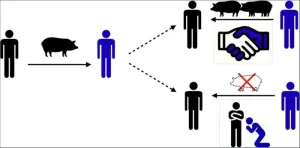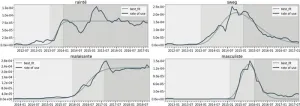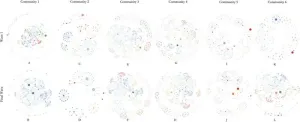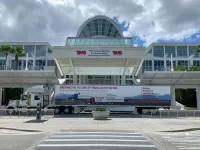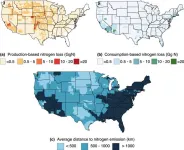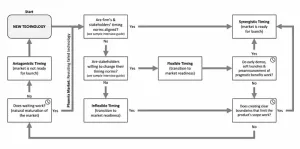(Press-News.org) New findings provide quantitative criteria for classifying social organizations in human history, together with potential explanatory variables that can be empirically measured for anthropology, history, and archaeology, according to a study published September 3, 2024 in the open-access journal PLOS Complex Systems by Kenji Itao and Kunihiko Kaneko from the University of Tokyo, Japan and Copenhagen University, Denmark (Kaneko) and the RIKEN Center for Brain Science, Japan (Itao).
Human societies have experienced transitions between different types of organizations, including bands, tribes, chiefdoms, and kingdoms. However, quantitative characterizations of the types and mechanisms of transitions have yet to be established. Meanwhile, anthropologists have observed that gift giving is prevalent in traditional societies and that it enhances social status by imposing reciprocal obligations on others.
In the new study, Itao and Kaneko present a simple model of competitive gift giving that describes how gifts bring goods to the recipient and honor to the donor, and simulate social change. In particular, the authors demonstrated that competitive gift giving generates socioeconomic disparities characterized by power law distributions of wealth and social reputation.
Numerical simulations revealed transitions between four phases with different distribution shapes of wealth and social reputation. The phases included the band, without economic or social disparities; the tribe, with economic but without social disparities; the chiefdom, with both; and the kingdom, with economic disparity and weak social disparity except for an outlier, namely, the monarch. The emergence of strong disparities was characterized by power law distributions and was attributed to the rich-get-richer process. In contrast, the absence of such a process led to exponential distributions due to random fluctuations. In addition, the phases depended on parameters characterizing the frequency and scale of gift interactions.
In other words, the emergence of several phases of social organizations are quantitatively characterized by the shape of the wealth and reputation score distributions. In the band phase, both distributions are exponential. In the tribe phase, only the wealth distribution obeys a power law. In the chiefdom phase, both distributions are power laws. And in the kingdom phase, the score distribution is exponential for all individuals except the monarch.
Overall, the results demonstrate the emergence of four phases of social organizations characterized by the degrees of economic and social disparities. The study also provides theoretical support for empirical findings that band societies have less economic inequality than do the other classes, that the presence of social inequality distinguishes chiefdoms and kingdoms from the others, and that monarchs are outliers in the distribution. According to the authors, their constructive model, guided by social scientific theory, can provide the basic mechanistic explanation of social evolution and integrate theories of the social sciences.
The authors add: "Gift-giving interactions drive social change. Its frequency and extent determine social organization structures."
############
In your coverage, please use this URL to provide access to the freely available article in PLOS Complex Systems: https://journals.plos.org/complexsystems/article?id=10.1371/journal.pcsy.0000001
Citation: Itao K, Kaneko K (2024) Emergence of economic and social disparities through competitive gift-giving. PLOS Complex Syst 1(1): e0000001. https://doi.org/10.1371/journal.pcsy.0000001
Author Countries: Denmark, Germany, Japan
Funding: This research was supported by the Grant-in-Aid for Scientific Research (A) (20H00123) from the Ministry of Education, Culture, Sports, Science, and Technology (MEXT) of Japan, JSPS KAKENHI Grant Number JP21J21565 (KI), and Novo Nordisk Fonden Grant Number NNF21OC0065542 (KK). The funders had no role in study design, data collection and analysis, decision to publish, or preparation of the manuscript.
END
The more centrally connected someone is within their social media network, the more likely that new words they use will become adopted into mainstream language, according to a new study published this week in PLOS Complex Systems by Louise Tarrade of École Normale Supérieure, France, and colleagues.
Language evolves within a social context and variations in a language are always in competition with each other. In everyday language, words are constantly being created, but not all these words persist.
In the new study, researchers analyzed more than 650 million tweets written in French between 2012 and 2014 to identify ...
In US community efforts to prevent childhood obesity, women leaders with more experience and connections have the greatest impact.
####
In your coverage, please use this URL to provide access to the freely available article in PLOS Complex Systems: https://journals.plos.org/complexsystems/article?id=10.1371/journal.pcsy.0000004
Article Title: Determinants and facilitators of community coalition diffusion of prevention efforts
Author Countries: United States
Funding: TM, MP, and CE received funding from the ...
After four years, a guidebook for the future of autonomous trucking has driven across the finish line.
In 2020, the Virginia Tech Transportation Institute (VTTI) and 17 partners were awarded a $7.5 million grant from the U.S. Department of Transportation to develop a concept of operations. The final report, published in July, includes best practices for the implementation of automated driving systems (ADS) in large trucks and policy issues for fleets to consider across eight topic areas.
“We’re excited that the Federal Motor Carrier ...
A patient dozes off in a dental chair despite the anxiety of an impending procedure. A seemingly unremarkable act but — for dentists versed in the latest sleep research — this red flag hints at a life-threatening condition.
In a research review published in the Journal of the American Dental Association, Rutgers Health researchers identified dentists as an unexpected player in the battle against life-threatening sleep disorders.
The review suggests dental professionals have unique opportunities to screen for conditions such as obstructive sleep apnea, a disorder that affects millions of Americans and is linked to serious health risks, including cardiovascular ...
WASHINGTON, D.C. - Today, the U.S. Department of Energy (DOE) announced $125 million in funding for two Energy Innovation Hub teams to provide the scientific foundation needed to seed and accelerate next generation technologies beyond today’s generation of lithium (Li)-ion batteries. These multi-institution research teams, led by Argonne National Laboratory and Stanford University, will develop scientific concepts and understanding to impact decarbonization of transportation and incorporation of clean energy into the electricity grid.
Rechargeable batteries, such as Li-ion and lead-acid batteries, have had a ...
The University of Ottawa has been awarded a $1 million grant from the Ontario Research Fund – Research Excellence (ORF-RE) to support the “Secure, Intelligent and Trustworthy Ecosystems for Connected and Autonomous Vehicles” (SITE-CAV) project.
Led by Burak Kantarci,Full Professor, School of Electrical Engineering and Computer Science, uOttawa’s Faculty of Engineering, the project aims to accelerate the development and integration of connected and autonomous vehicles (CAVs – or vehicles equipped with sensors and decision-making software that drives and controls it without direct ...
Today the U.S. Department of Energy (DOE) announced the creation of two new Energy Innovation Hubs. One of the national hubs, the Energy Storage Research Alliance (ESRA), is led by DOE’s Argonne National Laboratory and co-led by DOE’s Lawrence Berkeley National Laboratory (Berkeley Lab) and Pacific Northwest National Laboratory (PNNL).
ESRA (pronounced ez-ruh) brings together nearly 50 world-class researchers from three national laboratories and 12 universities to provide the scientific ...
Anyone who’s researched ways to lower their environmental impact has likely heard they should eat less meat, particularly beef. Even at scale, cows are an inefficient way to feed people — it takes nearly four tons of water to recoup one ton of beef, and many farming practices emit greenhouse gasses and pollutants.
University of Pittsburgh researchers are the first to trace one of those pollutants, nitrogen, along the U.S. beef supply chain at the county level. They found high spatial disconnect between where ...
Virtual reality (VR) video games that combine screen time with exercise are a great way to get fit, but game designers face a major challenge – like with regular exercise, adherence to ‘exergames’ is low, with most users dropping out once they start to feel uncomfortable or bored.
Computer scientists at the University of Bath believe they’ve found a solution: create exergames that use sensors to continuously measure a person’s emotional state while they exercise, then tweak the game – for instance, making ...
New research from Bayes Business School (formerly Cass) finds that being on the cutting edge of technology is not enough to ensure success in the market, and managers must strategically time launches to create a source of opportunity and credibility for the firm.
The study, led by Dr Thomas Robinson, Senior Lecturer in Marketing at Bayes, with Dr Ela Veresiu, Associate Professor of Marketing at Schulich School of Business, York University, Toronto, develops a framework for guiding organisations on the best situations for a product launch.
The research identifies four timing situations that can confront marketing managers. Knowing ...
